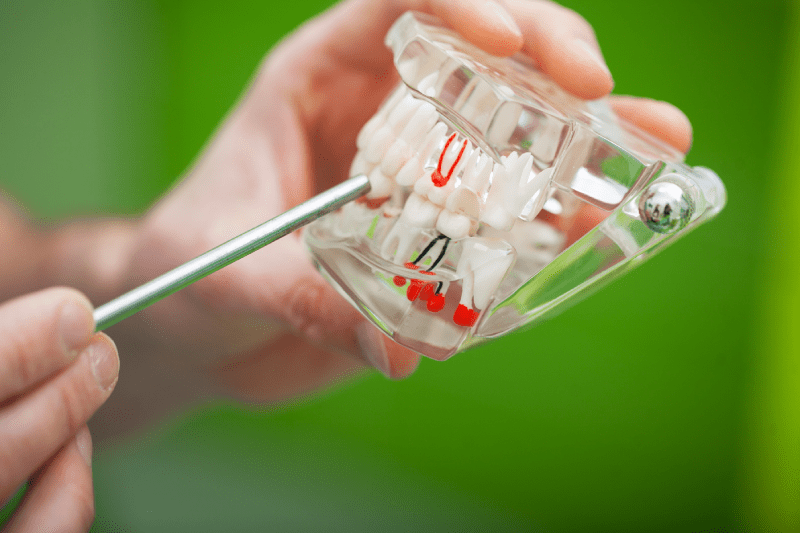What Is a Dental Bridge and Who Is It Suitable For?
A dental bridge is a fixed prosthesis used to replace one or more missing teeth. This procedure fills the gap of the missing tooth by taking support from neighboring teeth. It is generally an ideal solution for individuals who have healthy and strong teeth on both sides of the missing tooth. It is also a suitable alternative for patients who cannot get an implant or prefer not to. Before starting the treatment, your dentist will evaluate your oral and dental health in detail to decide whether a bridge is the right option for you.
What Materials Can a Dental Bridge Be Made Of?
Dental bridges can be made from different materials for aesthetics and durability. The most common materials used include porcelain, zirconia, and porcelain-fused-to-metal. Porcelain-fused-to-metal bridges are more economical and offer strength, but do not provide as natural an aesthetic appearance as porcelain and zirconia. Zirconia bridges offer the closest appearance to natural teeth with their light-transmitting structure and do not carry an allergy risk as they contain no metal. Each material has its advantages and disadvantages, and the choice depends on the patient’s expectations, budget, and the dentist’s recommendations.
How Long Does the Dental Bridge Procedure Take?
The dental bridge procedure is a process that typically requires two to three visits. On the first visit, the abutment teeth are prepared for the bridge, and an impression is taken. This stage takes about one hour. After the impression is taken, a temporary bridge is placed. On the second visit, the fit of the permanent bridge, prepared in the laboratory, is checked. This visit is usually shorter and is completed by cementing the bridge permanently. In some complex cases or when additional treatments are needed, the procedure time may be extended.
Does Getting a Dental Bridge Hurt?
The dental bridge procedure is generally painless because local anesthesia is administered during the process. You will not feel any pain while the abutment teeth are being prepared. You may experience slight sensitivity or pain after the procedure, but this usually subsides on its own within a few days and can be controlled with over-the-counter painkillers. The removal of the temporary bridge and placement of the permanent one is also a comfortable process for most patients. If you feel any pain or discomfort, it is important to share this with your dentist.
What Is a Temporary Bridge and How Long Is It Used?
A temporary bridge is a provisional structure used to protect the abutment teeth while the permanent bridge is being prepared in the laboratory. This bridge prevents sensitivity of the prepared teeth, helps you maintain chewing function, and provides an aesthetic appearance. It is typically used for a short period, such as one to two weeks. During this time, it is important to avoid very hard or sticky foods to prevent the temporary bridge from coming loose or getting damaged.
What Is the Lifespan of Dental Bridges?
The lifespan of dental bridges varies depending on the quality of the material used, the patient’s oral hygiene habits, and regular dental check-ups. A well-cared-for bridge can last for fifteen years or more. Regular brushing, flossing, and periodic dental check-ups are the most important ways to extend the life of the bridge. If oral hygiene is neglected, cavities or gum disease can develop under the bridge, which can lead to its early failure.
Can Gum Disease Occur Under the Bridge?
Yes, if proper care is not taken, cavities or gum disease can occur in the teeth under the bridge. This happens due to plaque buildup in the area where the bridge joins the gum. Therefore, meticulous cleaning of the entire area around the bridge is vital. Using special floss, interdental brushes, and oral irrigators to keep the area under and around the bridge clean helps prevent such problems.
Do I Need to Have My Teeth Pulled to Get a Bridge?
No, teeth do not need to be pulled to get a dental bridge. On the contrary, the procedure is designed to fill the gap of the missing tooth. However, if the teeth to be used as abutments are weakened by problems such as cavities or inflammation, the dentist may recommend treating these teeth or, in some cases, pulling them. In such a situation, new and healthy teeth must be identified to support the bridge.
Is There a Difference Between a Dental Bridge and a Normal Tooth?
A properly made dental bridge is quite similar to natural teeth in both function and appearance. Especially zirconia or full porcelain bridges mimic the light-reflecting properties of natural teeth, offering an excellent aesthetic look. However, there may be some differences in feeling; a bridge does not move like a natural tooth because it is not attached to a tooth root. Still, patients usually get used to this feeling quickly and feel the bridge as if it were their own natural teeth.
Does a Dental Bridge Improve Chewing Function?
Absolutely. Missing teeth can seriously affect chewing function because chewing pressure is unevenly distributed among the other teeth in the mouth. A dental bridge fills the gap of the missing tooth, ensuring that the chewing force is evenly distributed throughout the mouth. This allows you to eat more efficiently and comfortably. At the same time, pain and discomfort felt during chewing are also reduced.
How Much Do Dental Bridges Cost?
The cost of dental bridges varies greatly depending on the type of material used (porcelain, zirconia, porcelain-fused-to-metal), the number of bridges required, and the dentist’s experience. Aesthetic and durable materials like zirconia are more expensive than metal-supported bridges. Also, if additional treatments (e.g., tooth extraction or root canal treatment) are required, the cost may increase. For the most accurate price information, you can get a customized treatment plan from your dentist after a detailed examination.
How Should Care Be Taken After Dental Bridge Treatment?
After dental bridge treatment, maintaining good oral hygiene is crucial to preserving the health of the bridge and the abutment teeth. Your dentist will show you how to clean under the bridge using special floss or an oral irrigator. In addition to brushing your teeth at least twice a day and flossing regularly, it is also important to limit the consumption of sugary and acidic foods.
What Foods Should I Avoid After Getting a Bridge?
After a permanent bridge is placed, it may be beneficial to avoid very hard or sticky foods for the first few days. Such foods can damage the bridge or weaken the adhesive. You should be careful with foods like nuts, caramel, hard bread crusts, and ice. Soft, easy-to-chew foods should be preferred. However, once the bridge is fully settled and the patient is used to it, they can return to their normal diet.
How Do I Clean Under the Bridge?
Cleaning under the bridge requires special tools such as special floss or a water jet (oral irrigator). Bridge floss is a special type of floss with a stiff plastic end that can be easily threaded through the teeth. This allows you to reach the space under the bridge and clean out plaque. Oral irrigators can effectively clean between teeth and under the bridge with water pressure. Your dentist will show you the most suitable cleaning method for you.
Is There an Age Limit for Dental Bridge Treatment?
There is no specific age limit for dental bridge treatment. The suitability of the treatment depends on the patient’s general health and oral structure. Generally, it can be applied to a wide age range from young adults whose jawbone development is complete to elderly individuals. This treatment is usually not recommended for children and adolescents as their permanent teeth have not yet fully settled. The important thing is that the abutment teeth are strong enough.
Is Getting an Implant a Better Option Than a Bridge?
Dental implants and bridges offer different advantages. Implants allow a root to be placed in the location of the missing tooth without touching the neighboring teeth. This is a great advantage in terms of protecting adjacent teeth. However, an implant is a surgical procedure and requires a longer healing process. Bridges, on the other hand, offer a faster solution and do not require surgery. The best option should be decided with your dentist based on your oral health, budget, and personal preferences.
Does Bad Breath Occur After Dental Bridge Treatment?
Bad breath after dental bridge treatment is usually associated with insufficient oral hygiene. Food debris and plaque buildup under the bridge and around the abutment teeth create a suitable environment for bacteria that cause bad odor. To prevent this, you need to regularly apply the special cleaning methods mentioned above. As long as proper care is taken, bridges do not cause bad breath.
Can a Dental Bridge Be Placed Over Decayed Teeth?
Dental bridges are not placed over decayed teeth. Bridges are used to fill the gap of a missing tooth. However, if the teeth to be used as abutments have cavities, these teeth must first be treated. The abutment teeth must be healthy and strong for the stability of the bridge. If the decay is too advanced and the tooth cannot be saved, it may be necessary to extract the tooth and create a new treatment plan.
Will My Teeth Become Sensitive After a Dental Bridge Is Placed?
It is normal to experience slight sensitivity after a dental bridge is placed, especially for the first few days. This sensitivity can be to cold, hot, or sweet foods. The reason for the sensitivity is that the abutment teeth are trying to adapt to the bridge. This condition usually goes away on its own within a few days. If the sensitivity persists or worsens, it is important to contact your dentist.
Do Dental Bridges Close the Gaps in My Teeth?
Dental bridges are designed to close the gaps created by missing teeth. Gaps between teeth can not only impair chewing function but also lead to teeth shifting and aesthetic problems. The bridge fills the missing tooth gap, providing both a functional and aesthetic solution. This way, the balance of the oral structure is maintained and other teeth are prevented from shifting.

How Many Teeth Do I Need to Get a Bridge?
To get a dental bridge, you need to have at least two healthy and strong abutment teeth, one in front and one behind the missing tooth. These teeth secure the bridge and hold it over the missing tooth gap. If there is no tooth on one side of the gap or if the teeth are not strong enough, your dentist may suggest a different treatment method, such as an implant-supported bridge.
Does a Dental Bridge Look Like a Natural Tooth?
Modern dental bridges, especially when made with materials like zirconia and porcelain, offer an aesthetic very similar to natural teeth. The color, shape, and size are designed to match the adjacent teeth, so the bridge gains a natural look that is not noticeable in the mouth. Your dentist will work with you to achieve the most natural result.
Does Getting a Bridge Affect My Lip and Facial Structure?
Yes, missing teeth can cause changes in the lip and facial structure over time. The jawbone can erode in the area of the missing tooth, leading to a more aged and sunken facial appearance. A dental bridge helps support the jawbone by filling the missing tooth gap and contributes to preserving the facial structure. This provides a more youthful and plump appearance.
Do Dental Bridges Improve My Speech Function?
Missing teeth can make it difficult to pronounce certain sounds correctly during speech and can lead to speech impediments. A dental bridge helps the tongue find its correct position by filling the missing tooth gap. This improves speech function, and sounds are pronounced more clearly and correctly. This is more pronounced when there is a missing front tooth.
Do Dental Bridges Increase My Chewing Power?
Dental bridges significantly increase your chewing power. Chewing becomes difficult in the area of missing teeth, and food cannot be fully ground. The bridge takes over the role of the missing tooth, ensuring that the chewing pressure is distributed evenly across all teeth. This also contributes positively to the digestive system and improves your overall oral health.
How Long Does the Bridge Placement Procedure Take?
The permanent bridge placement procedure usually takes less than an hour. During this process, your dentist checks the color and fit of the bridge. The bridge is cemented to the abutment teeth with a special adhesive. If you feel discomfort during the procedure, your dentist can give you additional anesthesia. You can return to your normal life immediately after the procedure.
Is There a Gap Between My Bridge and Teeth?
A professionally made dental bridge should be in perfect harmony with the abutment teeth, and there should be no gap between them. If a gap remains between the bridge and the teeth, this can lead to food debris accumulation and cavities. Your dentist will take very precise measurements and check the fit to ensure that the bridge sits perfectly on your teeth.
Does the Tooth Under the Bridge Hurt?
Pain under the bridge tooth may be a sign of an underlying problem. This problem can be a cavity in the abutment teeth, gum inflammation, or food debris accumulated under the bridge. If you feel pain in or under your bridge, it is important to contact your dentist immediately for an evaluation.
Does Getting a Dental Bridge Improve Aesthetic Appearance?
Dental bridges, especially those made with materials like porcelain and zirconia, significantly improve aesthetic appearance, particularly in cases of missing front teeth. They offer the closest aesthetic to natural teeth and restore your smile. This allows you to feel more confident in your social life.
How Long Does It Take for My Teeth to Heal After Bridge Treatment?
Full recovery after dental bridge treatment varies from person to person. Generally, temporary sensitivity subsides within a few days. It may take a few weeks for the bridge to fully settle and for the patient to get used to the new situation. To speed up the healing process, it is important to follow your dentist’s recommendations and establish a good oral hygiene routine.
Does Getting a Dental Bridge Prevent My Teeth From Shifting?
Yes, getting a dental bridge prevents teeth from shifting. Missing teeth can cause neighboring teeth to shift into the empty space. This can lead to misalignment and chewing problems. A dental bridge fills the missing tooth gap, helping to keep the adjacent teeth in place and preserve the teeth alignment.
Which Teeth Are Prepared for the Bridge Procedure?
For the bridge procedure, the adjacent teeth on both sides of the missing tooth gap are prepared. These are called “abutment” teeth. The dentist removes a small amount of the surface of these teeth to allow the bridge to sit comfortably and be secured. This is necessary for the bridge to provide a perfect aesthetic and functional fit.
What Is the Difference Between a Bridge Tooth and an Implant Tooth?
A bridge tooth fills the missing tooth gap by taking support from neighboring teeth. An implant, on the other hand, is a tooth mounted on an artificial root placed in the jawbone. While bridges rely on neighboring teeth, implants are independent structures. Bridges are a faster solution, but implants offer a more permanent and natural solution in the long run.
Can Dental Bridge Treatment Be Reversed?
Dental bridge treatment cannot be reversed because the abutment teeth are permanently altered to secure the bridge. However, the bridge itself can be replaced if needed. When a problem occurs with the bridge or it reaches the end of its lifespan, your dentist can remove the bridge and make a new one.
Will My Tooth Hurt After Getting a Bridge?
It is normal to feel a slight pain or sensitivity for the first few days after getting a bridge. This condition can be easily managed with painkillers. However, severe or prolonged pain could be a sign of a problem under the bridge. In this case, you should consult your dentist without delay.
How Safe Is Dental Bridge Treatment?
Dental bridge treatment is a widely used and safe dental restoration method worldwide. The procedure has a high success rate when performed with modern techniques and materials. Success depends on your dentist’s experience and your oral hygiene. With regular check-ups and good care, you can use your bridge safely.
I hope these questions have clarified the questions in your mind about dental bridge treatment. For more information on these topics or to learn about treatment options in Turkey, you can contact Cure Holiday. I wish you a healthy smile!



